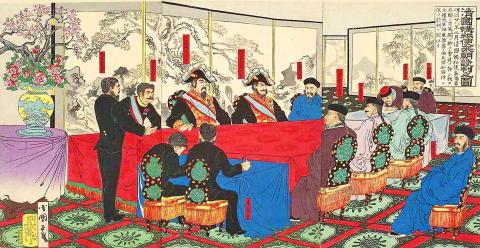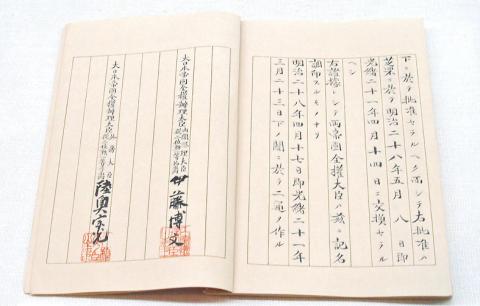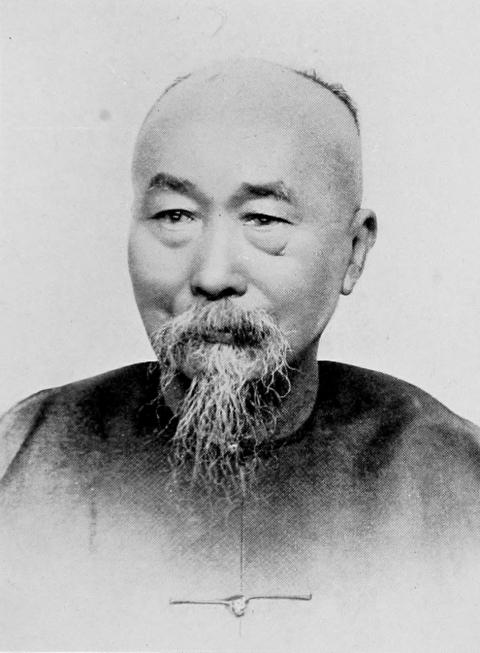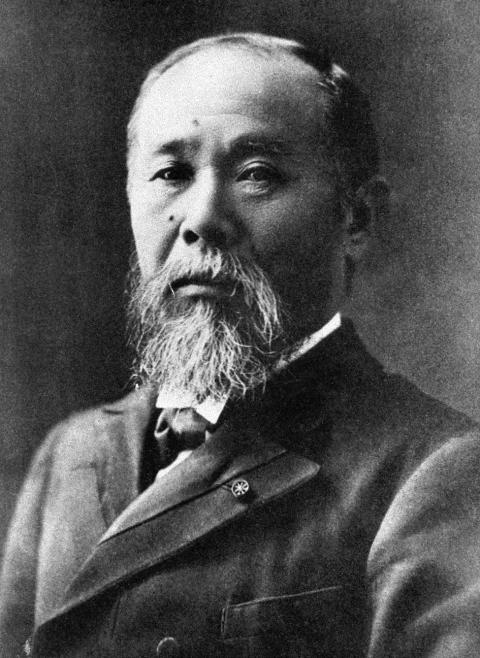April 17 to April 23
Just eight days after being shot in the cheek during an assassination attempt, Qing Dynasty official Li Hongzhang (李鴻章) emerged healthy enough for the first round of peace negotiations with the Empire of Japan at the tail end of the First Sino-Japanese War.
After about eight months of military conflict, the two sides signed a three-week armistice on March 30, 1895, with the Qing Empire as the clear loser. Over the next 18 days, Li and Japanese prime minister Ito Hirobumi met several times, finally signing the Treaty of Shimonoseki on April 17 — one of the conditions being that the Qing cede Taiwan and Penghu to Japan.

Photo courtesy of Wikimedia Commons
Despite opposition from Qing officials to the ceding of Taiwan, there was not much room for discussion. According to The Sino-Japanese War of 1894-95 by S.C.M. Paine, the armistice that the Japanese emperor offered did not include Taiwan and Penghu, and although Japan ceased its march on Beijing, it sent a force to Penghu on March 23 and swiftly occupied the entire archipelago before treaty negotiations began.
COVETED ISLANDS
Japan had long been interested in Taiwan because of its strategic location. As early as 1593, Toyotomi Hideyoshi sent an envoy to Taiwan to demand tribute, which was unsuccessful because there was no central government during that time. Talks of occupying Taiwan continued and intensified in the 1800s, with Westernization advocate Sato Nobuhiro proposing that Japan take Taiwan and use it as a base to assault China.

Photo courtesy of Wikimedia Commons
Taking Taiwan became an integral part of Japan’s expansion strategy after the Meiji Restoration. Plans were made long before the war began. In 1887, general Ogawa Mataji wrote, “Taiwan and Penghu are parts of the Qing Empire which many countries are drooling over … We must take these two islands. We shall heavily fortify them … and use them to control the central and southern provinces of the Qing Empire as well as a base for our southward expansion.”
These views were repeated by many politicians during the later stages of the war, several stating that if they did not capitalize on this victory to take Taiwan, it would almost certainly be swallowed up by a Western power. General Kawakami Soroku even advised Ito that agreeing to a ceasefire and obtaining Taiwan would prove far more valuable in 100 years than continuing the war and attacking Beijing.
Japan’s intentions were no secret. During the first meeting between Ito and Li on March 20, 1895 to discuss the ceasefire, Ito asked about the character of the people of Taiwan.

Photos courtesy of Wikimedia Commons
“Surely you mention this because you want to conquer Taiwan,” Li replied. “No wonder you don’t want to stop the war. But I’m sure that the UK would not just watch and let you occupy Taiwan.”
Ito replied that the matter was between Japan and the Qing, and third parties should not be considered.
“We’ve already made Taiwan a province, and there’s no way we will give it to another country,” Li stated. The Qing obviously had little clout in the negotiations as the losing side, and three days later, Japan attacked Penghu anyway.

Photos courtesy of Wikimedia Commons
Interestingly, according to A Study on Ming and Qing Policy Toward Taiwan (明清對台政策之研究) by Chen Chin-chang (陳錦昌), the Western powers were surprised at Japan’s decisive victory and changed their stance to supporting its demand for Taiwan.
THE NEGOTIATIONS
As expected, Japan immediately asked for Taiwan and Penghu during treaty negotiations. Since Japan requested both the Liaodong Peninsula in Northeast China and Taiwan, there was much debate in the Qing court about which one to give up if pressed.
Li tried to persuade Ito to only take Penghu on the grounds that Japan should only be entitled to territories it had already occupied. But Ito remained adamant. Li then offered Ito mining rights in Taiwan, while the Qing would keep the land and people. Ito threatened to resume war.
The Qing court then instructed Li to at least fight to retain the northern half of Taiwan. Ito replied, “having two countries govern one island will only lead to more problems in the future.”
With Japan unwilling to budge, the Qing court had no choice but to sign the treaty. The people of Taiwan were obviously in shock, and imperial scholars around China also submitted letters to the Qing court opposing the treaty.
Lin Chien-lung (林乾隆) writes in Study of Negotiations during the Treaty of Shimonoseki (中日馬關條約談判條約之研究) that the Qing included a protest letter from the people of Taiwan at the last minute before the two parties exchanged treaties on May 8, only to have Japan threaten war again.
Two hours before the ceasefire was up, the treaty went into force. Japanese troops landed on May 29, and the imperial power's 50-year control over Taiwan began.
Taiwan in Time, a column about Taiwan’s history that is published every Sunday, spotlights important or interesting events around the nation that have anniversaries this week.

That US assistance was a model for Taiwan’s spectacular development success was early recognized by policymakers and analysts. In a report to the US Congress for the fiscal year 1962, former President John F. Kennedy noted Taiwan’s “rapid economic growth,” was “producing a substantial net gain in living.” Kennedy had a stake in Taiwan’s achievements and the US’ official development assistance (ODA) in general: In September 1961, his entreaty to make the 1960s a “decade of development,” and an accompanying proposal for dedicated legislation to this end, had been formalized by congressional passage of the Foreign Assistance Act. Two

Despite the intense sunshine, we were hardly breaking a sweat as we cruised along the flat, dedicated bike lane, well protected from the heat by a canopy of trees. The electric assist on the bikes likely made a difference, too. Far removed from the bustle and noise of the Taichung traffic, we admired the serene rural scenery, making our way over rivers, alongside rice paddies and through pear orchards. Our route for the day covered two bike paths that connect in Fengyuan District (豐原) and are best done together. The Hou-Feng Bike Path (后豐鐵馬道) runs southward from Houli District (后里) while the

March 31 to April 6 On May 13, 1950, National Taiwan University Hospital otolaryngologist Su You-peng (蘇友鵬) was summoned to the director’s office. He thought someone had complained about him practicing the violin at night, but when he entered the room, he knew something was terribly wrong. He saw several burly men who appeared to be government secret agents, and three other resident doctors: internist Hsu Chiang (許強), dermatologist Hu Pao-chen (胡寶珍) and ophthalmologist Hu Hsin-lin (胡鑫麟). They were handcuffed, herded onto two jeeps and taken to the Secrecy Bureau (保密局) for questioning. Su was still in his doctor’s robes at

Mirror mirror on the wall, what’s the fairest Disney live-action remake of them all? Wait, mirror. Hold on a second. Maybe choosing from the likes of Alice in Wonderland (2010), Mulan (2020) and The Lion King (2019) isn’t such a good idea. Mirror, on second thought, what’s on Netflix? Even the most devoted fans would have to acknowledge that these have not been the most illustrious illustrations of Disney magic. At their best (Pete’s Dragon? Cinderella?) they breathe life into old classics that could use a little updating. At their worst, well, blue Will Smith. Given the rapacious rate of remakes in modern